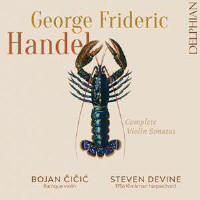Texte paru dans: / Appeared in:
|
|
|
|
|
|
It’s beginning to feel a bit like buses with Bojan Čičič : you spend ages thinking how enjoyable it would be if he were to record a solo sonata disc to complement his many superlative concerto albums, and then two come along at once. What’s more, those who enjoyed his recent solo Bach (10/23) are likely to be very pleased here, too, because what remains constant is his warmly unfussy delivery – clean tone, phrasing gently and elegantly shaped, drawing out beautiful long lines via flowing articulation which injects just the tiniest bit of air between the notes – and intimatefeeling lyricism. There’s also the draw for harpsichord lovers of Steven Devine’s close partnering being from the glorious twomanual harpsichord built in 1756 by Jacob Kirckman of London, quilled throughout in real quill.
It’s worth outlining what you will and won’t find on this disc. Obviously it includes the five full-length sonatas we know to be indisputably by Handel: the Sonata in G (HWV358), composed probably around 1710, plus the sonatas in D minor (HWV359a), A (HWV361) and G minor (HWV364a) from the 1720s, and the sublime D major Sonata (HWV371) written around 1749. Then, of the more spurious sonatas appearing in the 1730s collections from London publisher John Walsh and Amsterdam publisher Jeanne Roger, Čičič ´ gives us the Roger pair in A (HWV372) and E (HWV373), rather than Walsh’s G minor (HWV368) and F (HWV370) – so if you’re expressly in the market for the Walsh ones, I’d head either to Andrew Manze and Richard Egarr (Harmonia Mundi, 11/01), whose gently red-blooded and more legato approach works a dream in the beautiful F major, or to The Brook Street Band (Avie, 8/18) if you fancy string continuo in the mix and a slightly brighter sound. C?i?ic´, though, does also present an array of single ‘orphan’ movements that don’t turn up in every Handel collection, of which perhaps the most interesting of all is the single-stave Allegro in G, HWV407, penned in the leftover space on a discarded Serse violin part in 1738, and sounding much like an experiment in Bach-style solo violin-writing. This vignette sounds very lovely indeed under Čičič ´’s fingers – notably more leisurely paced than Adrian Butterfield’s reading (Somm, 2/08) but still meeting the Allegro brief, and with a softly rubato’d spaciousness and intimacy that feels closer to Bach’s more introspective beauty; and it’s then a neat tip into the indisputably merry Allegro opening the G major Sonata, HWV358, typifying the thoughtful programming that sometimes follows key and sometimes period.
There are so many other examples I could cite of the thoughtfulness and elegance, the range of colours and moods and the close musical conversation across this programme, all crisply captured in St Martin’s Church, East Woodhay, Hampshire. If you like your Handel to come with its emotions and colourings a bit more theatrical or obviously extrovert at points, or with a more excited nip to some of its allegro movements, this may not be completely what you’re after. Listen long enough, though, and you might find yourself being won over in spite of yourself. |
|




